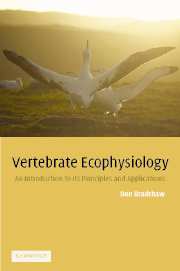Book contents
- Frontmatter
- Contents
- Introduction
- 1 Homeostasis: a fundamental organising paradigm in ecophysiology
- 2 Stress: the concept and the reality
- 3 Basic methods used in ecophysiological studies
- 4 Turnover methodology: theory and practice
- 5 Case studies of stress: incidence and intensity
- 6 Survival in deserts
- 7 Torpor and hibernation in cold climates
- 8 Marine birds and mammals
- 9 Conclusion
- Appendix 1 Population estimation methods
- Appendix 2 Estimation of food intake in Tiliqua rugosa
- Appendix 3 Simultaneous measurement of sodium and potassium concentration in plasma or urine using the IL 143 digital flame photometer
- Appendix 4 Determination of plasma urea nitrogen
- Appendix 5 Radioimmunoassay of testosterone in plasma
- Appendix 6 Preparation of ‘stripped plasma’
- Appendix 7 Radioimmunoassay of testosterone in faeces
- Appendix 8 The comparative method
- Appendix 9 Basic turnover equations
- References
- Index
1 - Homeostasis: a fundamental organising paradigm in ecophysiology
Published online by Cambridge University Press: 05 June 2012
- Frontmatter
- Contents
- Introduction
- 1 Homeostasis: a fundamental organising paradigm in ecophysiology
- 2 Stress: the concept and the reality
- 3 Basic methods used in ecophysiological studies
- 4 Turnover methodology: theory and practice
- 5 Case studies of stress: incidence and intensity
- 6 Survival in deserts
- 7 Torpor and hibernation in cold climates
- 8 Marine birds and mammals
- 9 Conclusion
- Appendix 1 Population estimation methods
- Appendix 2 Estimation of food intake in Tiliqua rugosa
- Appendix 3 Simultaneous measurement of sodium and potassium concentration in plasma or urine using the IL 143 digital flame photometer
- Appendix 4 Determination of plasma urea nitrogen
- Appendix 5 Radioimmunoassay of testosterone in plasma
- Appendix 6 Preparation of ‘stripped plasma’
- Appendix 7 Radioimmunoassay of testosterone in faeces
- Appendix 8 The comparative method
- Appendix 9 Basic turnover equations
- References
- Index
Summary
The concept of ‘homoiostasis’ is now a central one in many sciences and its widespread use and utility attests to the genius of the American physiologist Walter Cannon, to whom we owe the original insight. Cannon coined the term in 1929 and defined homeostasis homeostasis as ‘ … the coordinated physiological processes which maintain most of the steady states in the organism’ (Cannon, 1929). He then went on to employ it with great success in his later books and publications (see Cannon, 1939) and the concept is now a central one in biology as well as in other fields such as engineering, economics and information technology. The idea of a process of self-regulation is based, however, on the earlier studies and speculations of the great French physiologist Claude Bernard, who first suggested that animals regulate and hold constant an internal state or milieu intérieur that is quite different from that of the environment around them. As he states in his famous textbook of ‘lessons’ published in Paris in 1878
I believe that I am the first to have proposed this idea that animals in reality possess two environments: an external environment in which the animal is situated and an internal environment in which are found the tissue elements.
(Bernard, 1878)The more recent concept of an idea, or theory, functioning as a paradigm comes from the work of the American philosopher Thomas Kuhn, who coined this term to describe the way in which whole scientific communities suddenly change the way in which they interpret and describe phenomena.
- Type
- Chapter
- Information
- Vertebrate EcophysiologyAn Introduction to its Principles and Applications, pp. 1 - 7Publisher: Cambridge University PressPrint publication year: 2003



